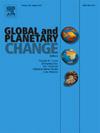Mid-Piacenzian and future changes in South Asian precipitation under global warming
IF 4
1区 地球科学
Q1 GEOGRAPHY, PHYSICAL
引用次数: 0
Abstract
This study examines the response of South Asian precipitation to global warming during the mid-Piacenzian and in the near future, using modeling data. Compared to the preindustrial period, both the mid-Piacenzian simulations from the Pliocene Model Intercomparison Project Phase 2 and the future projections under the Shared Socioeconomic Pathways 5–8.5 consistently indicate a wetter climate over South Asia, characterized by higher annual net precipitation. Concurrently, simulations show strengthened summer southeasterly winds over the Arabian Sea. The simulated climate anomalies under the mid-Piacenzian conditions align with the paleoclimatic evidence derived from geological records. Based on the validity of the simulated results in the past, together with the similarity to the future projections, it can be inferred that South Asia will continue to experience a wetter climate driven by increasing anthropogenic greenhouse gas emissions. Further analysis reveals that the wetter climate is primarily driven by increased net precipitation during summer and autumn. A moisture budget analysis indicates that the summer wetting over the Indian Peninsula and the Bay of Bengal is caused by thermodynamic mechanisms, which can be attributed to higher atmospheric humidity of the Intertropical Convergence Zone. In contrast, the autumn wetting over the same region is driven by dynamic processes, linked to enhanced cross-equator moisture transport under a positive Indian Ocean Dipole mean state. Additionally, the orographic precipitation is enhanced in the Himalayas and the Western Ghats during both summer and autumn. A key difference between the two warming scenarios is that the wetting is stronger under mid-Piacenzian warming, despite greenhouse gas concentrations being significantly higher in the future scenario. This discrepancy is suggested to be related to the offsetting influence of an El Niño-like mean state, which suppresses South Asian precipitation in the future scenario.
求助全文
约1分钟内获得全文
求助全文
来源期刊

Global and Planetary Change
地学天文-地球科学综合
CiteScore
7.40
自引率
10.30%
发文量
226
审稿时长
63 days
期刊介绍:
The objective of the journal Global and Planetary Change is to provide a multi-disciplinary overview of the processes taking place in the Earth System and involved in planetary change over time. The journal focuses on records of the past and current state of the earth system, and future scenarios , and their link to global environmental change. Regional or process-oriented studies are welcome if they discuss global implications. Topics include, but are not limited to, changes in the dynamics and composition of the atmosphere, oceans and cryosphere, as well as climate change, sea level variation, observations/modelling of Earth processes from deep to (near-)surface and their coupling, global ecology, biogeography and the resilience/thresholds in ecosystems.
Key criteria for the consideration of manuscripts are (a) the relevance for the global scientific community and/or (b) the wider implications for global scale problems, preferably combined with (c) having a significance beyond a single discipline. A clear focus on key processes associated with planetary scale change is strongly encouraged.
Manuscripts can be submitted as either research contributions or as a review article. Every effort should be made towards the presentation of research outcomes in an understandable way for a broad readership.
 求助内容:
求助内容: 应助结果提醒方式:
应助结果提醒方式:


